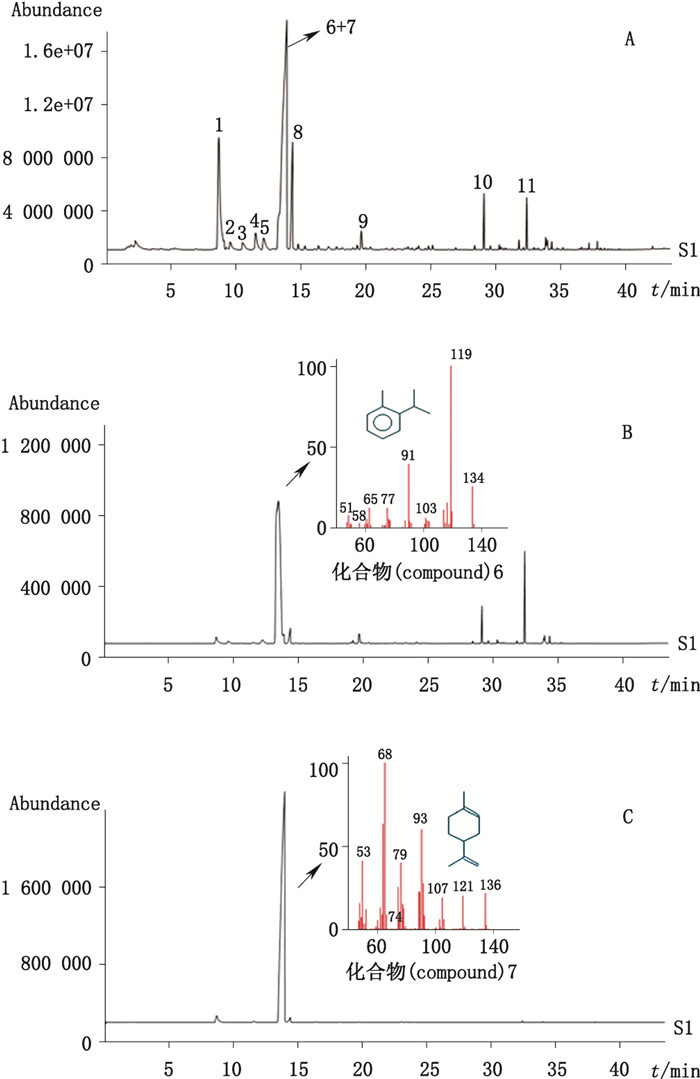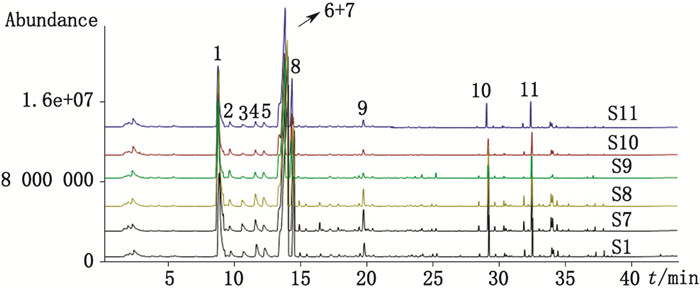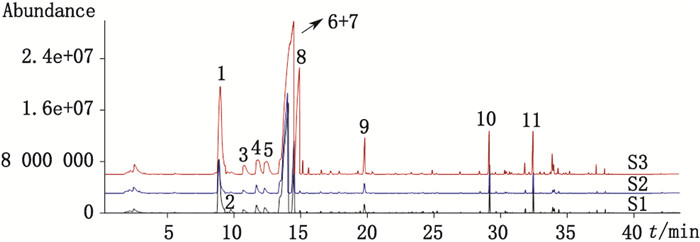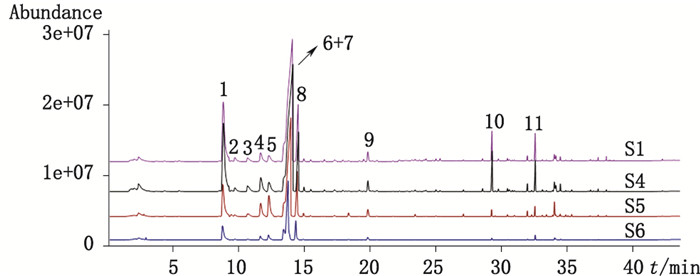雪菊(Coreopsis tinctoria Nutt.),又名两色金鸡菊,维吾尔语称之为“古丽恰依”,系菊科金鸡菊属一年生草本植物[1]。雪菊原产于美国中西部地区,后被引进我国,主要分布在新疆和田地区海拔3 000 m以上的昆仑山区[2-3]。作为维吾尔医习用药材之一,雪菊具有清热解毒、活血化瘀、和胃健脾之功效[4-5]。雪菊花可当茶饮用,用于治疗燥热烦渴、高血压、心慌、胃肠不适、食欲不振、痢疾及疮疖肿毒等疾病[5-9]。已有研究报道挥发油为雪菊的主要活性成分之一[10-12]。挥发油是重要的生物活性成分,多具有祛痰、止咳、镇痛、抗菌消炎、抗氧化等作用[10, 12-13]。然而雪菊挥发油的具体化学成分尚不明确,并且对雪菊不同产地和部位挥发油的对比分析也鲜有报道。
本文应用顶空进样,气相色谱-质谱联用方法分析比较不同产地雪菊花和其不同部位中挥发性成分,旨在了解生长环境对雪菊挥发性成分影响及雪菊地上部分综合利用的可能性。
1 仪器与材料 1.1 仪器Agilent 6890气相色谱仪,配置5973 NMSD质谱检测器;色谱柱为Agilent HP-5MS(5%-苯基)-甲基聚硅氧烷毛细管柱(30 m×0.25 mm×0.25 μm);进样器为CTC Combi PAL自动进样器。
1.2 材料表 1列出了同一采收期收集的雪菊样品(S1~S11),包括红色雪菊、不同产地黄色雪菊、同一产地黄色雪菊不同部位及不同物候期的雪菊样品。
|
|
表 1 雪菊样品信息 Table 1 Sample information of snow chrysanthemum |
称取粉碎后的样品粉末0.5 g,放入10 mL顶空瓶中密封,置顶空进样器中,按如下条件处理:样品瓶加热温度100 ℃;样品瓶加热时间30 min。
2.2 色谱条件色谱柱:Agilent HP-5MS毛细管柱(30 m× 0.25 mm×0.25 μm);顶空进样针温度105 ℃,进样量500 μL,进样口温度250 ℃;载气为He气,柱流量1.0 mL·min-1。程序升温条件:初始温度50 ℃,保持2 min,以2 ℃·min-1的速率升温至82 ℃,以4 ℃·min-1速率提升至150 ℃,最后以20 ℃·min-1升温至280 ℃,保持2 min。
2.3 质谱条件EI离子源,电子能量为70 eV,四极杆温度为150 ℃;接口温度为250 ℃;质量范围:m/z 50~500。图谱检索:NIST MS Search 2.0库。
2.4 样品测定采用上述实验方法对S1~S11样品的挥发性成分进行GC-MS分析。
3 结果与讨论 3.1 雪菊挥发性成分分析达坂城黄色雪菊样品(S1)经GC-MS分析后,参比Nist 2.0标准质谱库,取匹配度90%以上的结果,共鉴定出主要化合物11个,均约占样品中挥发性成分峰面积80%以上,说明雪菊中挥发性成分主要为萜烯类化合物,其总离子流图见图 1-A。从色谱峰6+7中鉴定出2个化合物,邻伞花烃和柠檬烯。两者主要的差异性离子为m/z 119(邻伞花烃,峰6)和m/z 68(柠檬烯,峰7),图 1-B和图 1-C为提取相应离子后的色谱图。11个化合物分别是1R-α-蒎烯(1)、4-亚甲基-1-(1-甲基乙基)双环[3.1.0]2-己烯(2)、β-水芹烯(3)、β-蒎烯(4)、α-水芹烯(5)、邻伞花烃(6)、柠檬烯(7)、(E)-β-罗勒烯(8)、别罗勒烯(9)、罗汉柏烯-I3(10)、2,6-二甲基-6-(4-甲基-3-戊烯基)双环[3.1.1]庚-2-烯(11)。

|
1. 1R-α蒎烯(1R-α-pinene)2. 4-亚甲基-1-(1-甲基乙基)双环[3.1.0]2-己烯(4-methylene-1-(1-methylethyl)bicyclo[3.1.0]hex-2-ene)3.β-水芹烯(β-phellandrene)4.β-蒎烯(β-pinene)5.α-水芹烯(α-phellandrene)6.邻伞花烃(o-cymene)7.柠檬烯(limonene)8.(E)-β-罗勒烯((E)-β-ocimene)9.别罗勒烯(allo-ocimene)10.罗汉柏烯-I3(thujopsene-I3)11. 2,6-二甲基-6-(4-甲基-3-戊烯基)双环[3.1.1]庚-2-烯(2,6-dimethyl-6-(4-methyl-3-pentenyl)bicyclo[3.1.1]hept-2ene) A.总离子流图(total ion chromatogram)B.提取离子图m/z 119(extract ion chromatogram m/z 119)C.提取离子图m/z 68(extract ion chromatogram m/z 68) 图 1 达坂城黄色雪菊的顶空GC-MS图谱 Figure 1 GC-MS chromatograms of yellow snow chrysanthemum from Dabancheng |
不同产地的黄色雪菊挥发性成分的种类差异不大,但含量差异较为明显(图 2,表 2)。该结果说明雪菊的生长环境对其挥发性成分有一定的影响。克里阳一级黄色雪菊挥发性成分含量较高并且克里阳地区雪菊挥发性成分含量基本与其品级相对应。阿叶地区多数挥发性成分含量略高于老叶克地区,说明海拔可能对雪菊挥发性成分的含量有一定影响。

|
图 2 不同产地雪菊顶空GC-MS图谱(峰号同图 1) Figure 2 GC-MS chromatogram of yellow snow chrysanthemum from different locations(peak No. is the same as in Fig. 1) |
|
|
表 2 不同产地及部位雪菊挥发性成分含量比较 Table 2 Comparison of content of volatile components in snow chrysanthemum from different parts and habitats |
达坂城黄色雪菊和红色雪菊中挥发性成分的种类和相对含量差异不大(图 3,表 2)。但雪菊中含量较高的挥发性成分1R-α蒎烯和柠檬烯,黄色雪菊的含量要多于红色雪菊。对于不同物候期的雪菊样品(图 3,表 2),胎菊中除4-亚甲基-1-(1-甲基乙基)双环[3.1.0]2-己烯外,主要挥发性成分的含量均远高于黄色雪菊。

|
图 3 不同品种及物候期雪菊顶空GC-MS图谱(峰号同图 1) Figure 3 GC-MS chromatogram of yellow snow chrysanthemum at different phenological periods(peak No. is the same as in Fig. 1) |
黄色雪菊不同部位挥发性成分的种类及含量有明显差异(图 4,表 2),黄色雪菊、雪菊种和雪菊叶中的主要挥发性成分种类一致,黄色雪菊茎的挥发性成分种类较少。从含量上分析,黄色雪菊种多数挥发性成分含量略高于黄色雪菊和雪菊叶,雪菊茎中的挥发性成分含量较低。此外,不同部位雪菊中主要挥发性成分为1R-α蒎烯和柠檬烯。蒎烯具有良好药物活性,包括抑菌、抗肿瘤、抗炎及抗氧化等作用[14-17]。柠檬烯也具有镇咳、祛痰、抑菌等作用[18]。因此,本研究对拓展雪菊药用部位,综合利用雪菊资源具有一定指导意义。
| [1] |
新疆植物志编辑委员会. 新疆植物志[M]. 第5卷. 乌鲁木齐: 新疆科技卫生出版社, 1999, 93. Editorial Committee of Flora of Xinjiang. Flora Xinjiangensis[M]. Vol 5. Urumqi: Xinjiang Science & Technology & Hygiene Publishing House, 1999, 93. |
| [2] |
CHEN LX, HU DJ, LAM SC, et al. Comparison of antioxidant activities of different parts from snow chrysanthemum (Coreopsis tinctoria Nutt.) and identification of their natural antioxidants using high performance liquid chromatography coupled with diode array detection and mass spectrometry and 2, 2'-azinobis(3-ethylbenzthiazoline-sulfonic acid)diammonium salt-based assay[J]. J Chromatogr A, 2016, 1428: 134. DOI:10.1016/j.chroma.2015.10.037 |
| [3] |
LAM SC, LAM SF, ZHAO J, et al. Rapid identification and comparison of compounds with antioxidant activity in Coreopsis tinctoria herbal tea by high-performance thin-layer chromatography coupled with DPPH bioautography and densitometry[J]. J Food Sci, 2016, 81(9): C2218. DOI:10.1111/1750-3841.13402 |
| [4] |
中国科学院中国植物志编辑委员会. 中国植物志[M]. 第75卷. 北京: 科学技术出版社, 1979, 365. Editorial Committee of Flora of China, Chinese Academy of Sciences. Flora of China[M]. Vol 75. Beijing: Science Press, 1979, 365. |
| [5] |
木合不力·阿不力孜, 张兰, 张敏, 等. 昆仑雪菊中氨基酸含量的分析[J]. 医药导报, 2011, 30(4): 43. MOURBOUL A, ZHANG L, ZHANG M, et al. Determination of amino acids in Coreopsis tinctoria flowers from Kunlun mountain[J]. Her Med, 2011, 30(4): 43. |
| [6] |
梁淑红, 庞市宾, 刘晓燕, 等. 金鸡菊提取物降血脂作用的动物试验研究[J]. 农垦医学, 2009, 31(6): 234. LIANG SH, PANG SB, LIU XY, et al. A laboratory study on the effects of reduing blood lipid with Coreopsis extracts in hyperlipemia model mice[J]. J Nongken Med, 2009, 31(6): 234. |
| [7] |
LAM SC, LIU X, CHEN XQ, et al. Chemical characteristics of different parts of Coreopsis tinctoria in China using microwave-assisted extraction and high-performance liquid chromatography followed by chemometric analysis[J]. J Sep Sci, 2016, 39(15): 2919. DOI:10.1002/jssc.v39.15 |
| [8] |
陈刚, 帕丽达, 朱军, 等. 立地条件对昆仑雪菊品质的影响[J]. 中国现代中药, 2013, 15(12): 1060. CHEN G, PALIDA, ZHU J, et al. Effect of site condition on quality of Kunlun snow chrysanthemum[J]. Mod Chin Med, 2013, 15(12): 1060. |
| [9] |
江苏省植物研究所. 新华本草纲要[M]. 上海: 上海科学技术出版社, 1988, 22. Institute of Botany, Jiangsu Province. Compendium of New China (Xinhua) Herbal[M]. Shanghai: Shanghai Science and Technology Publishers, 1988, 22. |
| [10] |
张彦丽, 韩艳春, 阿依吐伦·斯马义, 等. GC-MS对昆仑雪菊挥发油成分的研究[J]. 新疆医科大学学报, 2010, 33(11): 1299. ZHANG YL, HAN YC, AYTULUN S, et al. Analysis of essential oil from Kunlun chrysanthemum by GC-MS[J]. J Xinjiang Med Univ, 2010, 33(11): 1299. DOI:10.3969/j.issn.1009-5551.2010.11.008 |
| [11] |
沈维治, 邹宇晓, 刘凡, 等. 顶空固相微萃取气质联用分析比较雪菊与市售菊花的挥发性成分[J]. 热带作物学报, 2013, 34(4): 771. SHEN WZ, ZOU YX, LIU F, et al. Analysis and comparison of volatile components from the Coreopsis tinctoria and commercial chrysanthemum by GC-MS with headspace solid-phase microextraction[J]. Chin J Trop Crop, 2013, 34(4): 771. |
| [12] |
WANG T, XI MQ, GUO QS, et al. Chemical components and antioxidant activity of volatile oil of a compositae tea (Coreopsis tinctoria Nutt.) from Mt.Kunlun[J]. Ind Crop Prod, 2015, 67: 318. DOI:10.1016/j.indcrop.2015.01.043 |
| [13] |
吴立军. 天然药物化学[M]. 第5版. 北京: 人民卫生出版社, 2007, 256. WU LJ. Medicinal Chemistry of Natural Products[M]. 5th Ed. Beijing: People's Medical Publishing House, 2007, 256. |
| [14] |
SILVA A, LPOES P, AZEVEDO M, et al. Biological activities of α-pinene and β-pinene enantiomers[J]. Molecules, 2012, 17(6): 6305. |
| [15] |
WANG W, LI N, LUO M, et al. Antibacterial activity and anticancer activity of Rosmarinus officinalis L.essential oil compared to that of its main components[J]. Molecules, 2012, 17(3): 2704. |
| [16] |
BAE G, PARK K, CHOI S, et al. Protective effects of α-pinene in mice with cerulein-induced acute pancreatitis[J]. Life Sci, 2012, 91(17/18): 866. |
| [17] |
AYDIN E, TRKEZH H, GEYIKOGLU F. Antioxidative, anticancer and genotoxic properties of α-pinene on N2a neuroblastoma cells[J]. Biologia, 2013, 68(5): 1004. |
| [18] |
钱宗耀, 安冉, 华震宇, 等. 固相微萃取气质联用分析新疆雪菊的挥发性成分[J]. 中国实验方剂学杂志, 2014, 20(7): 94. QIAN ZY, AN R, HUA ZY, et al. Analysis of volatile compounds from Coreopsis ticntoria with solid phase microextraction by GC/MS[J]. Chin J Exp Tradit Med Form, 2014, 20(7): 94. |
 2018, Vol. 38
2018, Vol. 38 

